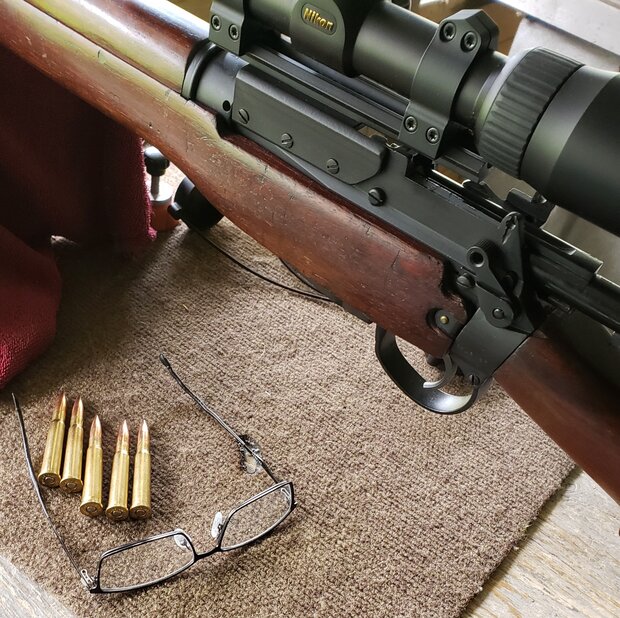Copyright 2022 – Stephen Redgwell
Many Canadians own a 303 British. Most of them are buried in the back of a gun locker and probably haven’t seen the light of day in years. I suppose they’ve been ignored because they’re either old, a bad thing to be these days, or it’s too difficult to find a decent .311 bullet. I get that.

But a lot of the barrels are worn or shot out. I’ve convinced a few people to replace them with a 308 barrel. It is an affordable option that gives an all steel and wood rifle new life. This should interest anyone who doesn’t like polymer stocks, plastic trigger guards or stamped metal parts. It really gets the attention of other shooters who see your targets – they think were made using an old, surplus 303!
I rebarreled my first 303 into a 30-303 years ago because I was shooting military matches and my favourite No 4 barrel wore out.
It was much easier finding good bullets for a 308 barrel, and naturally, my scores improved. It wasn’t a surprise. A lot of money was spent developing quality 308 bullets for hunting and competition. Rebarreling my 303 British this way was a smart thing to do – despite its age.
So, there’s the improved accuracy. This is a no-brainer. Today’s barrels are miles ahead of what was made in the past. One can make the argument that today’s inexpensive factory barrels are better made than the ones pumped out during the wars. Barrel steel and manufacturing methods are much, much better.

The improved accuracy you’ll get from a new barrel is greatly enhanced by shooting bullets that fit! This is a huge gain! Yep. It doesn’t matter if it’s a hunting or competition bullet. It’s something that, even today, 303 shooters don’t realize. Well, the cast bullet shooters know, but that’s another story.
The bottom line is all commercially made 303 bullets by Hornady, Sierra, Speer and others, are undersized. The original plans called for a .314 barrel. Even the SAAMI specifications reflect this. Unfortunately, few people knew. The above picture shows what a correctly sized 155 grain bullet can do from my 30-303.

I also discovered that there isn’t any velocity difference between the 308 Winchester and a 30-303 with 150, 155 and 165 grain bullets.
Recently, I was cleaning up after a two day shoot and it occurred to me that my 308s cannot out shoot my 30-303 No4.
While I was at the work bench, I thought about loads for my 30-303 using 168 gr bullets. I wanted to start with known data, and thought that the 168 grain Speer loads would be a good baseline. I dug out some records from 12 years ago. These were work ups with 7.62x51mm IVI (military) cases for my Tikka HB rifle. I used this rifle in some 300 yd shoots. I didn’t win, but was complimented at the end of the day by the other shooters. Guys who shoot in competition are very supportive. They were impressed that I could hang in so long with a stock rifle and “cheap, surplus brass”.
Fast forward a week to the 2020 Christmas holidays. I discovered something which made me smile. Digging through a bunch of data from the 30-303 (both the No 4 and a Thompson Center Encore – I found this.
30-303 data — 168 gr. Speer Target Match – 2507.0 fps average of twelve powders
308 Win data — 168 gr. Hornady AMaxes – 2526.7 fps average of ten powders
There was no appreciable velocity difference between the two cartridges! It reinforced my belief that the 308 Winchester is a rimless copy of the 303 British and cannot outperform it.
